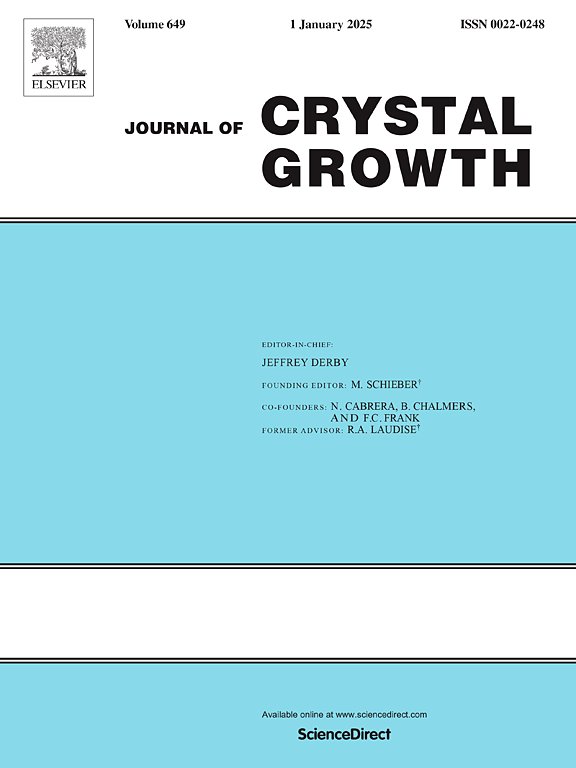带有人工晶界的硅晶体中的应力分析和位错簇生成
IF 1.7
4区 材料科学
Q3 CRYSTALLOGRAPHY
引用次数: 0
摘要
我们利用含有人造晶界的硅锭对各种晶界(GB)进行了位错和应力分析,以便对实验结果和分析结果进行系统比较。通过光致发光成像,我们发现在〈1 1 0〉取向晶界周围产生的位错簇数量明显高于在〈1 0 0〉取向晶界周围产生的位错簇数量。应力分析表明,这种差异与 GB 周围的最大剪应力有关。然而,尽管存在高剪切应力,但在某些 GB 上并未观察到位错簇的产生。对于大多数这些 GB,发现硅晶体 12 滑移系统中的最大剪切应力方向与生长方向呈斜向下,这似乎抑制了位错的传播。本文章由计算机程序翻译,如有差异,请以英文原文为准。
Stress analysis and dislocation cluster generation in silicon crystal with artificial grain boundaries
We conducted a dislocation and stress analysis on various grain boundaries (GBs) using silicon ingots that contained artificial GBs to permit systematic comparison of experimental and analytical results. Through photoluminescence imaging, we found that the number of dislocation clusters generated around the 〈1 1 0〉-oriented GBs was significantly higher than those around the 〈1 0 0〉-oriented GBs. The stress analysis revealed that this difference is linked to the maximum shear stress around the GB. However, there were some GBs where dislocation cluster generation was not observed despite the presence of high shear stress. For most of these GBs, the direction of the maximum shear stress in the 12 slip system of silicon crystal was found to be oblique downward to the growth direction, which appears to inhibit dislocation propagation.
求助全文
通过发布文献求助,成功后即可免费获取论文全文。
去求助
来源期刊

Journal of Crystal Growth
化学-晶体学
CiteScore
3.60
自引率
11.10%
发文量
373
审稿时长
65 days
期刊介绍:
The journal offers a common reference and publication source for workers engaged in research on the experimental and theoretical aspects of crystal growth and its applications, e.g. in devices. Experimental and theoretical contributions are published in the following fields: theory of nucleation and growth, molecular kinetics and transport phenomena, crystallization in viscous media such as polymers and glasses; crystal growth of metals, minerals, semiconductors, superconductors, magnetics, inorganic, organic and biological substances in bulk or as thin films; molecular beam epitaxy, chemical vapor deposition, growth of III-V and II-VI and other semiconductors; characterization of single crystals by physical and chemical methods; apparatus, instrumentation and techniques for crystal growth, and purification methods; multilayer heterostructures and their characterisation with an emphasis on crystal growth and epitaxial aspects of electronic materials. A special feature of the journal is the periodic inclusion of proceedings of symposia and conferences on relevant aspects of crystal growth.
 求助内容:
求助内容: 应助结果提醒方式:
应助结果提醒方式:


